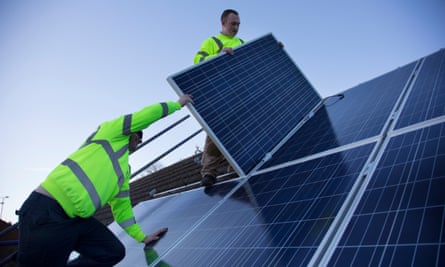The UK is well on the way to a new era of subsidy-free renewable energy projects that will largely kill off prospects for new gas power stations, according to industry analysts.
The falling cost of wind and solar projects combined with advances in battery storage technology will unlock about £20bn of investment in the UK between now and 2030, Aurora Energy Research said. Onshore wind and solar will both be viable without subsidies by 2025 in the UK, it added.
The prediction comes as the Swedish energy firm Vattenfall announced that it had won a Dutch government tender to develop a windfarm which will become the world’s first without subsidies when built off the Netherlands coast in 2022.
“The [subsidy-free] future is within reach,” Magnus Hall, Vattenfall’s chief executive, told an industry audience in Oxford.
But the switch to a post-subsidy world would still require some financial aid during the transition period, Hall said, to ensure that risk was fairly shared between energy firms and governments.
Hall urged ministers to consider reversing the UK’s ban on subsidies for onshore windfarms, saying developers of these projects should be allowed to compete in auctions for subsidies.
His call was echoed by two of the UK’s big six energy firms, SSE and ScottishPower.
Alistair Phillips-Davies, chief executive of SSE, said onshore windfarms should be given a chance where communities support them. “I’d like to see onshore wind coming back in the UK,” he said.
Keith Anderson, chief corporate office at Scottish Power, told the Guardian: “Let’s use it, let’s deploy it. There are still areas absolutely where we could build onshore windfarms, areas where the local community are acceptive of windfarms.”
Wind power is expected to account for half of the 18GW of subsidy-free renewables to be built in the UK between now and 2030, according to a new Aurora Energy Research report.

The other half will be from solar power, which had largely stalled after subsidy cuts in 2015 but received a boost when the UK’s first subsidy-free solar farm opened last year.
Having so much green energy generation will squeeze out the opportunity for the likes of Germany’s RWE to build large gas power stations in the UK.
The government has already downgraded the amount of new gas power capacity it expects to be added by 2030 from 22GW to 7GW, but Aurora said that would shrink to just 1GW if subsidy-free renewables took off as anticipated.
Mateusz Wronski, an analyst at Aurora, said: “The subsidy-free revolution is here and it’s big.”
Prices in the capacity market, the government’s scheme for guaranteeing power supplies during winter, have repeatedly been too low to encourage new large gas power plants to be built.
The energy minister, Claire Perry, announced on Tuesday that the government would be launching a formal review of the capacity market later this year. One consideration will be whether to open up the scheme to renewable energy projects, a step that would further hammer gas.
Perry said the cold snap at the start of March, which saw gas demand jump 40% above normal levels, had shown the UK energy system was robust but there are “lessons to be learned”.
